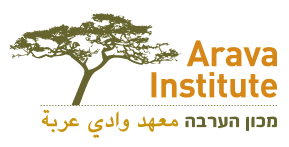
I asked Uzi to join us and present findings of ancient desert culture as a prologue to the world of the Bible, with a particular focus on the human relationship to the environment. We first went to Ma’aleh Shaharut where we were introduced to an ancient group of standing stones (Mahtzevot) representing gods. The connection to the Bible is twofold. We read in the Ten Commandments (Exodus 20:3-5 and Deuteronomy 5:8) that, “You shall have no other gods before me. You shall not make for yourself an image in the form of anything in heaven above or on the earth beneath or in the waters below. You shall not bow down to them or worship them.” In the pre-Biblical period, before we were told not to have images of God, physical representations of gods were made using stone pillars. And yet a few chapters later (Exodus 20:25), we read, “If you use stones to build my altar, use only natural, uncut stones. Do not shape the stones with a tool, for that would make the altar unfit for holy use.”
We learn from this that an echo from the ancient desert dwellers was heard by the authors of the Bible; for the standing stones that we were looking at were natural and uncut. Why did the stones for the altar need to be made from uncut stones? The Biblical understanding of God is that God is without form, without body. We can only see the results of God in the world. Or to put it another way, nature can be understood as a manifestation of God’s presence in the world. In that thinking, the uncut stones represent the direct work, the direct artistry of God. Both the desert dwellers and later Biblical writers found God’s presence not in the work of humans, but in nature left untouched by us.
At another site Uzi spoke to us about the change from building in the round to building with 90 degree square angles. Nomads, he explained, tend to build in the round. some of the ancient sites we were looking at, as well yurts, igloos, and teepees from other nomadic cultures. While more settled peoples, he told us, build their buildings more at square angles. In the Uvda Valley, there are also examples of such ancient structures with square angles, representing settled communities. Why the difference? Nomads roam to the rhythms and flow of nature; the shape of nature, for the most part, is more curved. Settled communities have greater impact on nature as they often make changes to it to serve their needs. Building with square angles represents an attempt to change and control nature. The interesting thing is that we tend to feel better in buildings that have curved walls and spaces. Scientists and psychologists have much to say about this very human dynamic.
When it came to build the present Arava Institute offices, in one of the old turkey coops of the kibbutz, the architect Ronit Duzi designed the inner walls of the offices and meeting room curved, applying an understanding from the local ancient desert dwellers to the building I sit in now. Many who enter the building comment on the “feel” of the building because of its curved walls. The wisdom and insights of those who lived in the desert millennia ago and how they lived with and understood nature has left its imprint in many places including the Bible and the offices of the Arava Institute for Environmental Studies.
Rabbi Michael Cohen teaches conflict resolution at Bennington College’s Center for the Advancement of Public Action (CAPA). He is one of the founding faculty members of the Arava Institute and continues to support its work from near and far. During the Fall 2016 semester, which he is spending in Kibbutz Ketura with his wife Alison, he is teaching the course “The Bible as a Key to Environmental Thought”, and blogging regular reflections on the Arava Institute and its surroundings.

